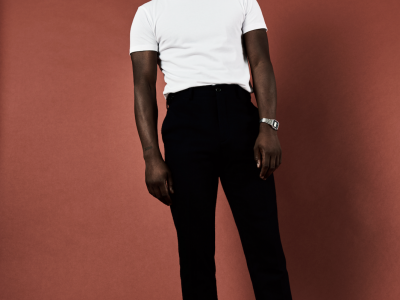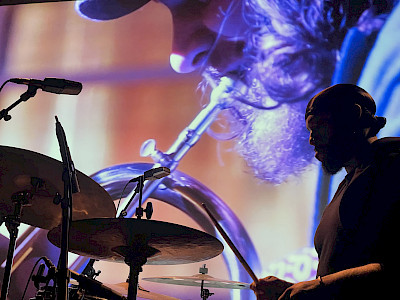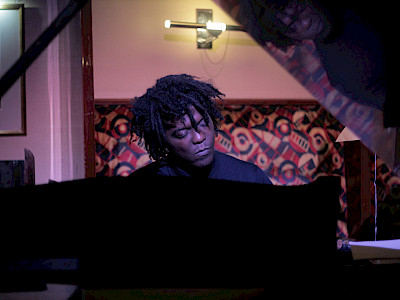15 — 17.05.2022
Inspired by Brussels and its multilingual vocality, Christophe Chassol has created a visually stimulating sonic portrait of the city for Kunstenfestivaldesarts. After last year’s online presentation of Chou, Chassol returns with a live performance of his new album dedicated to Brussels; a mesmerizing total experience with video and musicians. Chassol sparked a revolution in contemporary jazz and is known around the world through his albums, concerts, and collaborations with artists such as Frank Ocean and Solange. In the manner of an optical effect, he harmonizes melodies and rhythms, blending extraordinarily complex chord variations into sound combinations of unimaginable fluidity. This complexity is cloaked by seemingly effortless technique and unrestrained elegance, revealing the virtuosity, poetry, and musicality of everyday sounds and spoken language. Commissioned for the festival, Chou merges the image and sound archive of Brussels into a polyphonic portrait of the city. This unique creation will be presented at a series of symbolic locations: Ancienne Belgique, La Monnaie / De Munt, and L’Archiduc.
The Stream of Thoughts
A conversation between Christophe Chassol and Saskia De Ville
Saskia De Ville: Let’s start with the title, Chou, what does it evoke for you? Brussels sprouts? An affectionate nickname? Why did you choose this as a title?
Christophe Chassol: Following the interview I did with Jean-Pierre Muller, an artist friend of mine, I wanted to come up with a play on words, to use a pun for the title, because there’s something about the humour here. I searched through so many things – I tried writing Bruxelles backwards, but ultimately I thought it would be better to choose a title where the spectator makes the connection themself, in their head. If I say ‘chou’, you think of Brussels sprouts, of tenderness, but also of Romanesco cauliflower, and of its fractal structure: the triangle within the triangle within the triangle, etc. So I thought this would give me a plan for my film, that it would enable me to do things in mirror-image – which is what I did in the introduction, when we arrive
by train.
What is the introduction saying?
The introduction talks about the piano theme, which comes from something that Jean-Pierre Muller said to me. He said: “The problem with Brussels, it’s this. It’s that it is difficult to leave.” Which was a very good punchline, so I worked on the harmonisation of these words. I worked out some chords on this phrase, and that’s how I arrived at the piano motif.
Your film is based on a series of interviews. How do you go about contacting all the interviewees? What do you prepare before meeting them? Or do you leave room for the encounter, in a purely spontaneous way?
As a result of making films that are also albums and live performances, I know what suits me, I know the process, what works for me. When I prepare these interviews, I want to leave with material to mix – that I will enjoy working on. Here, I had two quite simple themes, two compositions, which I brought along and asked everyone to sing to me. And, for the meeting itself, I want them to tell me about who they are, where they come from, their childhood, what they are doing in Brussels… I therefore asked them to take me to a place that meant something to them.
In the film, we see Alice Foccroulle talking to you about recitative, ancient music. Is there a documentary part, in the sense that you don’t harmonise all the words? Did you also want to integrate the words as such into the film?
Yes, more than usual. When you don’t have harmonisation, melodised speech, it becomes more gripping when it arrives; it’s really listened-to differently if it is preceded by speech without music. What triggered me to start this work in 2005 were the films of Johan van der Keuken. They are just fantastic. You sense that he has a corpus of images that he’s filmed all over the world, and that, in a film about brass instruments – about brass bands in South America – he’ll be able to show you a sequence he filmed in a school for the blind in the 1970s… He makes Lego [constructions] with his own images and with the sound too. In the sequence with Alice, I wanted to reconstruct the encounter, with her talking to me about Schütz, about the composers. I stitch the sequences together with chord grids, with harmonic sequences. There are three or four different harmonic sequences that recur in the film, in different keys, and that allow me to sew the sequences together, the thread being the music.
Yet keeping this documentary aspect. Brussels is a multilingual city, so you work on the subtitles and play with the loops to offer both French and Dutch at the same time.
Subtitles have been part of my work for a while. I need for the voice to be considered as an instrument. Sometimes the voice can be drowned out and not mixed like in a song, where the voice is the most important element. So with subtitles, you’re involved as much in the understanding as in the music. I’ve done language harmonisations in Brazil, with Portuguese – which has many intervals, and in Vietnam, where there are a lot of semitones. I treat all languages the same: I get music. I’m aware that this is really a film about music, more than about Brussels.
Is there still an element of improvisation when you play the film live? Are you bound by the images or does the method leave you a certain amount of freedom?
You can compare the film to a classical music score. Where is the freedom in a classical music score? It is in the ritardandos, in the nuances. I know that at such and such a moment I must play a C-major. I have a thousand ways of playing my C-major, but even so, I have to play C-major. I can play on the nuances, I can do arpeggiated chords or I can play it on two keyboards, or just play the bass. I have a lot of freedom. What’s on the screen is locked, what I’ve recorded and edited is a guideline, a thread. We have the meetings, we’re magnetised by the score, but we can make side steps.
The fragrance that emanates from the film, in its entirety, is the sweetness you were speaking about earlier. Did you do this consciously?
For the previous performance, Ludi, I wanted to create a hyper-virtuoso object, where every single second something technical and funny happens, with lots of very rich things. For this performance [Chou] I wanted to go back to a bit of trance, to things that are more spread out, with more lengths and repetitions. The Steve Reich-like minimalist motif allows me to jump, pose, and hover. I wanted music that was a bit more cosmic.
I find it very accurate in terms of the vision I have of my city. To return to what you said at the beginning, “Brussels is a difficult city to leave.” Well, I’ve done that and – loo-king back – I find it all the more beautiful. Maybe that’s what you felt when you came to Brussels several times at different stages of the work and for the presentation of the project: with hindsight you look at it differently.
I’m in the film; I’m trying to see what it looks like. I think that coming back to play [in May 2022] is going to be pretty good too. This technique of harmonising and melodising fills me up – it allows me to swallow things, to keep the tools that were learnt ‘by heart’ in my bag, throughout my life. It’s difficult to explain the feeling, it is something that’s linked to the invisible, in the sense of music. For example, I’m attached to the film we made in New Orleans. For me, New Orleans is a particular sequence of chords. And here, this motif, this sequence of chords that you heard, that I found by melodising the phrase “The problem with Brussels, it’s this, it’s this…”, …Brussels will be associated with that. For me, Brussels will be associated with the fingers in a certain position on a keyboard, with a pattern, with a chord progression on the twelve notes, with a mental structure, with a fractal structure, perhaps like a ‘chou’, a Romanesco cauliflower.
Conversation transcribed by Lusik Cam and Nelson Kabeya
Discover the entire conversation between Christophe Chassol and Saskia De Ville
Presentation: Kunstenfestivaldesarts, Ancienne Belgique, De Munt/La Monnaie, L’Archiduc
Written, composed and directed by: Christophe Chassol | With: Jean-Pierre Muller, Alice Foccroulle, Inno JP, Tisso the Plug, Jean-Claude Vanden Eynden, Martha Da’ro, Jean-Philippe and Valentin Feiss, Aristide d’Agostino, Jean-Louis Hénart, Emmanuel André, Isabelle Leonard | Executive production: Boris Memmi, Géraldine Noël for Ludi Magister
Commissioned and produced by Kunstenfestivaldesarts and Ancienne Belgique | In coproduction with Ludi Magister
Thanks to: De Munt/La Monnaie, L’Archiduc, Wave Lab Studio, Hotel Warwick, Ville de Bruxelles/Stad Brussel
Performances in Brussels with the support of the French Institute, the French Embassy in Belgium and The Alliance Française, in the frame of EXTRA (2021)
Courtesy of Tricatel






